Why this resume works
- Quantifies accomplishments: Reducing downtime by 20% and managing a $500,000 budget showcases the applicant’s ability to quantify accomplishments effectively.
- Uses action-oriented language: Using action verbs like “implemented” and “coordinated,” the applicant conveys initiative and effectiveness.
- Illustrates problem-solving ability: Introducing a new safety program that reduced incidents by 15% highlights problem-solving skills.
More Maintenance Manager Resume Examples
These maintenance manager resume examples show how to showcase your leadership, technical skills, and experience in facility upkeep. Use these samples to create a resume that highlights your strengths for maintenance management roles.
Entry-level maintenance manager
Why this resume works
- Centers on academic background: Academic achievements are front and center, with a master’s in mechanical engineering, showcasing readiness for industry challenges.
- Sections are well-organized: Effective use of bullet points and headers makes the resume easy to scan, ensuring key achievements are quickly accessible and improving readability.
- Effective use of keywords: The strategic use of keywords such as “preventive maintenance” and “operational efficiency” boosts visibility in applicant tracking systems.
Mid-level maintenance manager
Why this resume works
- Includes a mix of soft and hard skills: Mixing technical expertise with interpersonal skills, the applicant demonstrates a harmonious mix of problem-solving and team leadership throughout their diverse maintenance roles.
- Points to measurable outcomes: With clear metrics like cutting downtime by 30% and boosting productivity by 25%, the applicant effectively quantifies their impact in maintenance management.
- Demonstrates language abilities: The applicant’s language skills in Spanish, French, and German improve cross-cultural communication in diverse communities.
Experienced maintenance manager
Why this resume works
- Focuses on work history: Using a chronological resume, the applicant organizes roles from technician to manager, showcasing steady career growth and extensive maintenance expertise over 15 years.
- Showcases impressive accomplishments: Achievements like saving $50,000 annually and reducing downtime by 30% through strategic initiatives reflect the applicant’s ability to deliver measurable impact.
- Emphasizes leadership skills: By leading teams of up to 15 members, improving efficiency by 25%, and managing operations across facilities, the applicant illustrates strong leadership skills in dynamic environments.
Maintenance Manager Resume Template (Text Version)
Cameron Henderson
St. Louis, MO 63102
(555)555-5555
Cameron.Henderson@example.com
Professional Summary
Seasoned Maintenance Manager with 4 years of experience in preventive maintenance, team leadership, and budget management, accomplished in improving operational efficiency and reducing costs.
Work History
Maintenance Manager
Pinnacle Facility Solutions – St. Louis, MO
April 2024 – August 2025
- Reduced downtime by 20% through preventive maintenance.
- Managed annual budget of $500,000 efficiently.
- Led a team of 10 in daily maintenance tasks.
Facilities Supervisor
GreenTech Manufacturing – St. Louis, MO
January 2022 – March 2024
- Implemented a safety program, cutting incidents by 15%.
- Oversaw equipment upgrades saving 10% on utilities.
- Coordinated contractor schedules, ensuring on-time projects.
Building Maintenance Coordinator
Streamline Operations – Parkview, MO
July 2021 – December 2021
- Executed daily maintenance for 5 locations diligently.
- Streamlined inventory control, reducing costs by 8%.
- Developed reporting system, increasing efficiency by 12%.
Skills
- Preventive Maintenance
- Budget Management
- Team Leadership
- Safety Compliance
- Equipment Upgrades
- Inventory Control
- Technical Troubleshooting
- Project Management
Education
Master of Science Facilities Management
University of California, Berkeley Berkeley, CA
June 2021
Bachelor of Science Mechanical Engineering
California State University, Fullerton Fullerton, CA
June 2019
Certifications
- Certified Facility Manager (CFM) – International Facility Management Association
- Building Operator Certification – Northwest Energy Efficiency Council
Languages
- Spanish – Beginner (A1)
- French – Intermediate (B1)
- German – Beginner (A1)
Related Resume Guides
Advice for Writing Your Maintenance Manager Resume
Crafting a strong resume is the first step to landing your next maintenance manager role.
Learn how to write a resume and discover practical tips to showcase your strengths and experience in facility management like a pro.
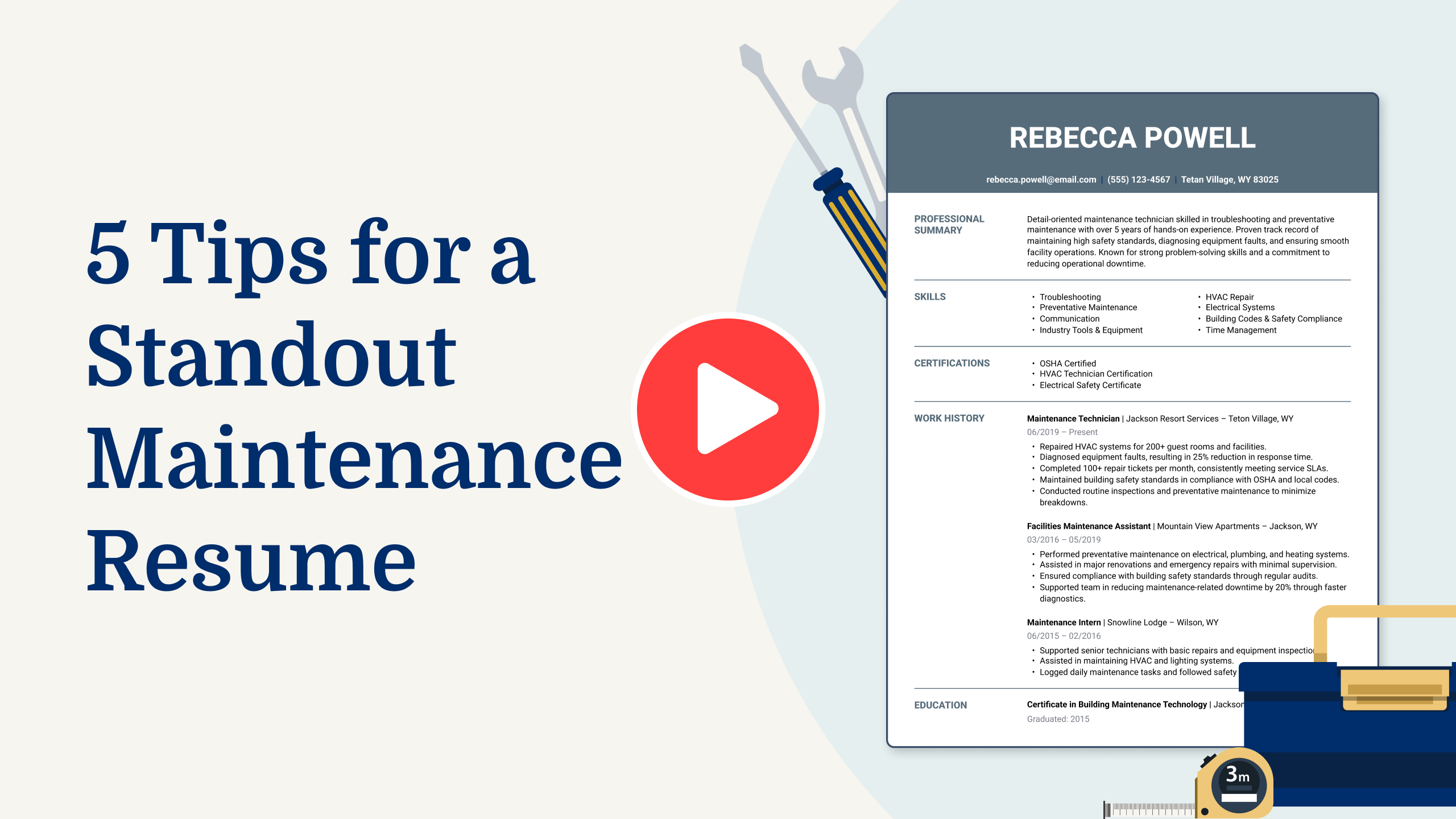
Highlight relevant technical skills
For a maintenance manager, technical skills are very important because they help you keep equipment and facilities running smoothly. It’s a good idea to have a technical skills section on your resume to show what you know and can do. You can also talk about these skills in the work experience section by explaining how you’ve used them in past jobs. This helps employers see that you have hands-on experience.
Some common technical skills for a maintenance manager include:
- Knowledge of electrical systems, HVAC systems, plumbing, and mechanical repair
- Being able to read blueprints or schematics
- Familiarity with computer-aided design (CAD) software and building management systems
- Safety practices and compliance with regulations
When writing about your technical skills, use simple language to describe what you can do. For example, say “Fixed electrical problems” instead of using industry-specific jargon. Be sure to list any specific tools or equipment you’re familiar with. This makes it clear what you’re bringing to the job as a maintenance manager.
Example of a technical skills section
- Cmms software (SAP PM, Maximo, eMaint)
- Preventive and predictive maintenance
- Root cause analysis (RCA) and failure mode effects analysis (FMEA)
- HVAC systems maintenance
- Electrical troubleshooting and repair
- Plumbing systems management
- OSHA compliance and safety standards
- Budgeting and cost control
- Team leadership and training
Employers care about soft skills like teamwork, communication, and adaptability as well, so make sure to include these on your resume. They help show you’re a good fit for the job.
Quantify your accomplishments
Quantifying accomplishments in a resume makes it stand out because it shows exactly what you have achieved and not just what you did. For a maintenance manager, this means turning daily tasks into measurable successes.
In the work experience section, start with your job title, employer name, location, and dates of employment. Then focus on how you improved things at your workplace. Did you save money by reducing costs? Did you boost efficiency or cut down repair times? Use numbers like percentages or dollar amounts to highlight these achievements.
Using action verbs along with metrics creates a results-driven resume. Instead of saying “responsible for equipment upkeep,” say something like “reduced equipment downtime by 30%.” This approach helps hiring managers quickly see your impact and skills just by glancing at your resume.
It turns ordinary duties into impressive stories of accomplishment that show why you’re fit for the maintenance manager role. By focusing on quantifiable results, you can effectively communicate the value you’ve brought to past employers and predict the potential benefits you’ll offer in future roles.
5 maintenance manager work history bullet point examples
- Led a team of 10 technicians in performing preventive maintenance on 50+ pieces of equipment, reducing downtime by 25%.
- Implemented a new inventory management system, decreasing parts ordering time by 20% and saving $15K annually.
- Developed and executed a comprehensive training program for staff, resulting in a 40% reduction in safety incidents.
- Coordinated with production and engineering teams to identify critical issues, improving overall equipment efficiency by 18%.
- Managed the installation and commissioning of new machinery, completing projects under budget by 10%.
Need help with your resume? Look at our professional resume examples to find styles that work and make yours stand out.
Write a powerful professional summary
A professional summary on a resume serves as an introduction to hiring managers. It helps them decide quickly if they want to learn more about you. You can choose between writing a summary or a resume objective, depending on your career stage and goals.
A professional summary is a short paragraph that highlights your work experience, key skills, and achievements. It’s best for experienced applicants who want to showcase their professional identity and the value they bring. This section answers “what I’ve accomplished in my career so far.”
Resume objectives, on the other hand, state your career goals. They are ideal for entry-level individuals, career changers, or those with employment gaps. Unlike summaries, objectives focus on “what I aim to contribute” in future roles.
Let’s review examples of both professional summaries and resume objectives tailored for different levels of experience. Whether you’re a maintenance manager with years of experience or just starting out, we’ll help you craft the right introduction for your resume.
Maintenance manager resume summary examples
Entry-level
Recent graduate with a Bachelor of Science in Mechanical Engineering, focusing on maintenance systems and equipment reliability. Completed internships that provided exposure to preventive maintenance strategies and hands-on experience with industrial machinery. Eager to apply knowledge of maintenance scheduling and troubleshooting in a dynamic environment.
Mid-career
Maintenance manager with over seven years of experience in manufacturing environments, specializing in reducing downtime through strategic maintenance planning and team leadership. Proven track record of implementing cost-saving measures and managing cross-functional teams to improve operational efficiency. Holds certifications in predictive maintenance technologies and adept at using CMMS software for workflow optimization.
Experienced
Seasoned maintenance manager with more than 15 years of experience leading large-scale maintenance operations across multiple facilities. Expertise in asset management, budget control, and team development, resulting in significant improvements in equipment uptime and cost reductions. Recognized for driving innovation through advanced predictive analytics and fostering a culture of continuous improvement.
Maintenance manager resume objective examples
Recent graduate
Detail-oriented recent engineering graduate with a focus on mechanical systems seeking an entry-level maintenance manager position. Eager to apply technical skills and fresh perspectives to support efficient facility operations and contribute to preventive maintenance strategies.
Career changer
Dynamic professional transitioning from a logistics background into maintenance management, bringing strong organizational skills and a problem-solving mindset. Seeking to leverage experience in coordinating complex operations to ensure smooth facility functioning and improve team productivity.
Specialized training
Certified in industrial maintenance technology, aiming for a role as a maintenance manager in a forward-thinking manufacturing environment. Passionate about applying specialized training in equipment diagnostics and repair to optimize machinery performance and extend asset life.
Select a resume template featuring clear section headers and simple fonts to ensure your information is easy to read, allowing employers to focus on your skills and experience without distraction.
Showcase your credentials
Having the right certifications, licenses, and technical training is essential for a maintenance manager. These credentials show that you have specialized knowledge and hands-on skills to handle equipment, safety protocols, and team management effectively.
Employers often look for certifications to confirm your ability to manage complex systems or meet industry standards. Including these in your resume can make you stand out and instill confidence in your capabilities. Commonly sought-after certifications for maintenance managers include:
- Certified Maintenance Manager (CMM)
- Facilities Management Professional (FMP)
- OSHA Safety Certification
- HVAC Technician Certification
- EPA Section 608 Technician Certification
Adding a dedicated certifications section highlights your professional qualifications and supports the experience listed on your resume. For a maintenance manager, showcasing these credentials helps employers see that you’re prepared for the technical demands of the role. Be sure to list them clearly so they’re easy to find.
Example of a certifications section
Certified Maintenance & Reliability Professional (CMRP)
Issued by: Society for Maintenance & Reliability Professionals (SMRP)
HVAC Excellence Certification
Issued by: ESCO Group
OSHA 30-Hour General Industry Safety and Health
Issued by: Occupational Safety and Health Administration (OSHA)
Certified Plant Maintenance Manager (CPMM)
Issued by: Association for Facilities Engineering (AFE)
EPA Section 608 Technician Certification
Issued by: Environmental Protection Agency (EPA)
Choose a chronological resume format if you have steady work history in your field, but opt for a functional or combination format if you’re changing careers, have employment gaps, or want to emphasize skills over job titles.
FAQ
Do I need to include a cover letter with my maintenance manager resume?
Yes, including a cover letter with your maintenance manager resume can give you an edge over other job seekers.
A cover letter provides an opportunity to highlight your leadership skills and experience in managing maintenance teams and projects, which might not be fully detailed on your resume.
If the company specializes in specific equipment or systems, you can discuss your expertise with those technologies or similar ones you’ve managed before.
Consider using our Cover Letter Generator to tailor your cover letter efficiently. This tool ensures it aligns well with the job description and showcases your strengths effectively.
Additionally, reviewing cover letter examples can offer insights into how to structure your own letter and emphasize key points relevant to a maintenance management role.
How long should a maintenance manager resume be?
For a maintenance manager, a one-page resume can work if you have limited experience, allowing you to focus on key skills like equipment management and team leadership.
However, if you’ve been in the field for several years or have numerous certifications and accomplishments, a two-page resume may be more appropriate. This allows you to detail your achievements in optimizing maintenance processes and managing large teams effectively.
Still unsure about how long your resume should be? Consider the depth of your experience and relevance of each section to decide what best fits your career journey.
How do you write a maintenance manager resume with no experience?
When crafting a resume with no experience, focus on highlighting transferable skills, education, and any relevant training that showcases your potential for the role. Use these elements to create an effective entry-level maintenance manager resume.
- Emphasize education: List any degrees or certifications related to maintenance management, including courses in mechanical engineering, facilities management, or technical training programs.
- Showcase transferable skills: Highlight skills such as problem-solving, project management, leadership, and teamwork. These can be gained from volunteer work, internships, or other roles you’ve held.
- Include relevant projects or coursework: Detail any projects or coursework where you managed resources, coordinated tasks, or dealt with equipment maintenance. This helps demonstrate practical knowledge even if it wasn’t in a professional setting.
Explore our guide on writing a resume with no experience for additional examples and actionable tips from Certified Professional Resume Writers.
Rate this article
Maintenance Manager
Additional Resources

Maintenance Manager Cover Letter Example + Tips
Using the free maintenance manager cover letter sample to guide you, you can work with your own experience to show how you are a good fit for the advertised job.

25 Interview Questions for Managers (With Answers & Tips)
Success in a management interview starts long before the conversation begins. Taking the time to prepare thoughtful responses to common interview questions for managers helps you clearly communicate leadership experience
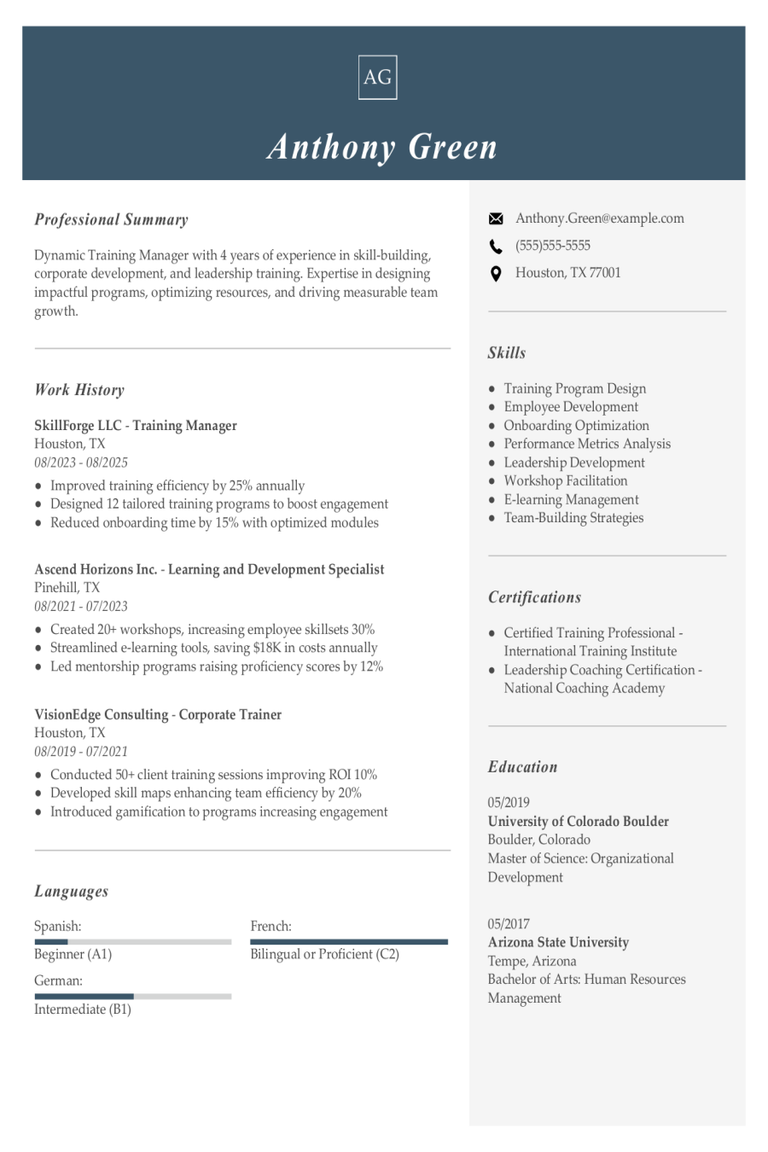
Training Manager Resume Examples & Templates for 2025
Discover how training managers showcase their skills in leading workshops and improving employee performance on their resumes. Our examples and tips will help you craft a resume that stands out
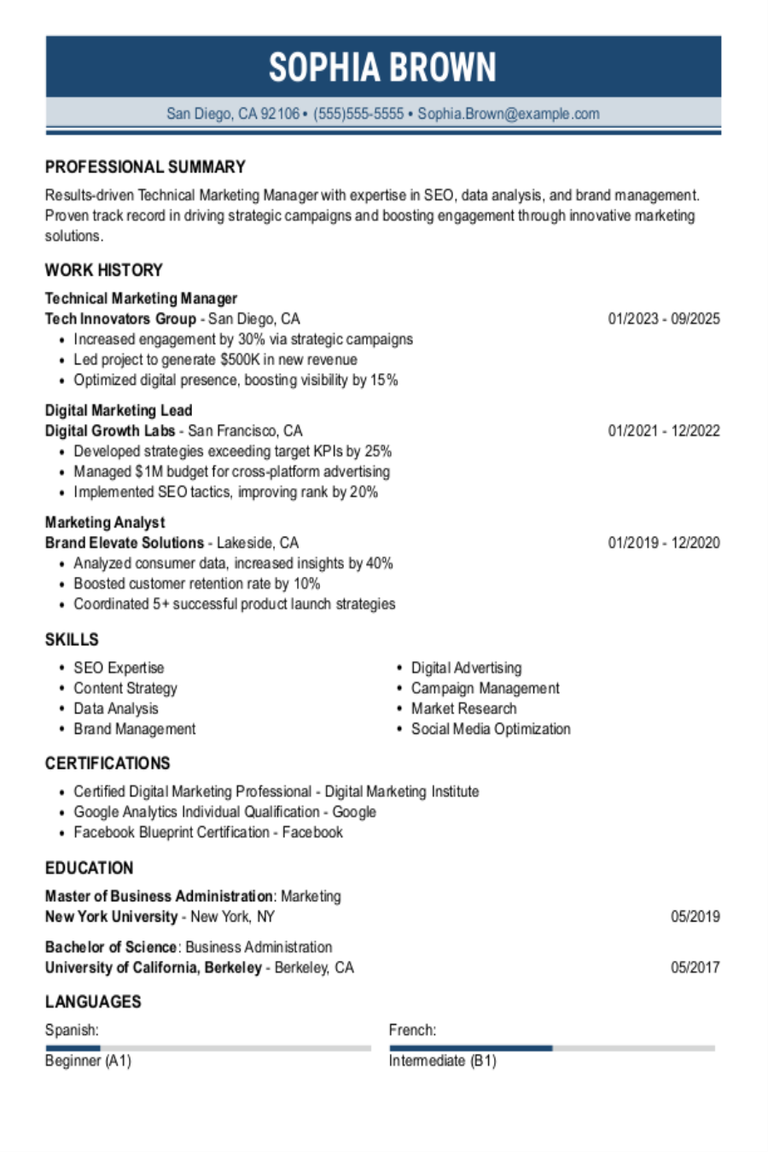
Technical Marketing Manager Resume Examples & Templates for 2025
Discover how to craft a technical marketing manager resume that shines. Learn to highlight your tech-savvy skills, marketing strategies, and project successes effectively.Build my resumeImport existing resumeCustomize this templateWhy this
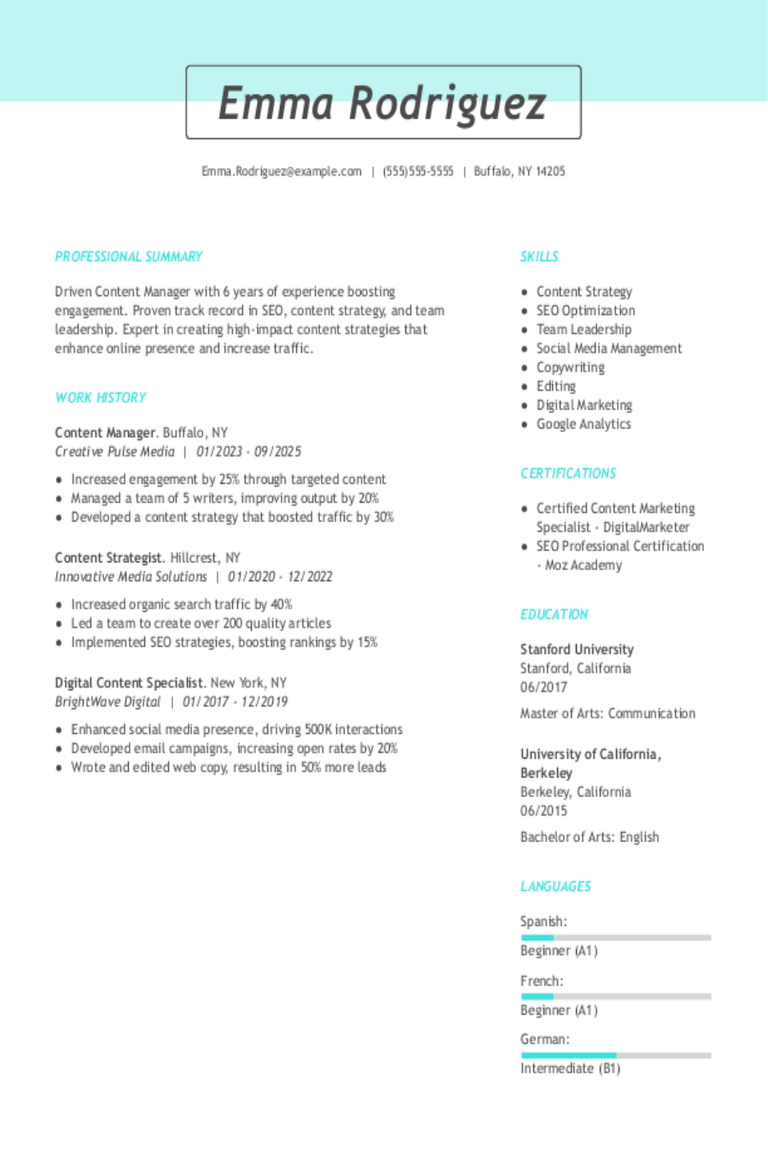
Content Manager Resume Examples & Templates for 2025
Browse content manager resume examples to see how to highlight your experience organizing, creating, and sharing engaging materials across platforms. These examples and tips help you showcase creativity, leadership, and
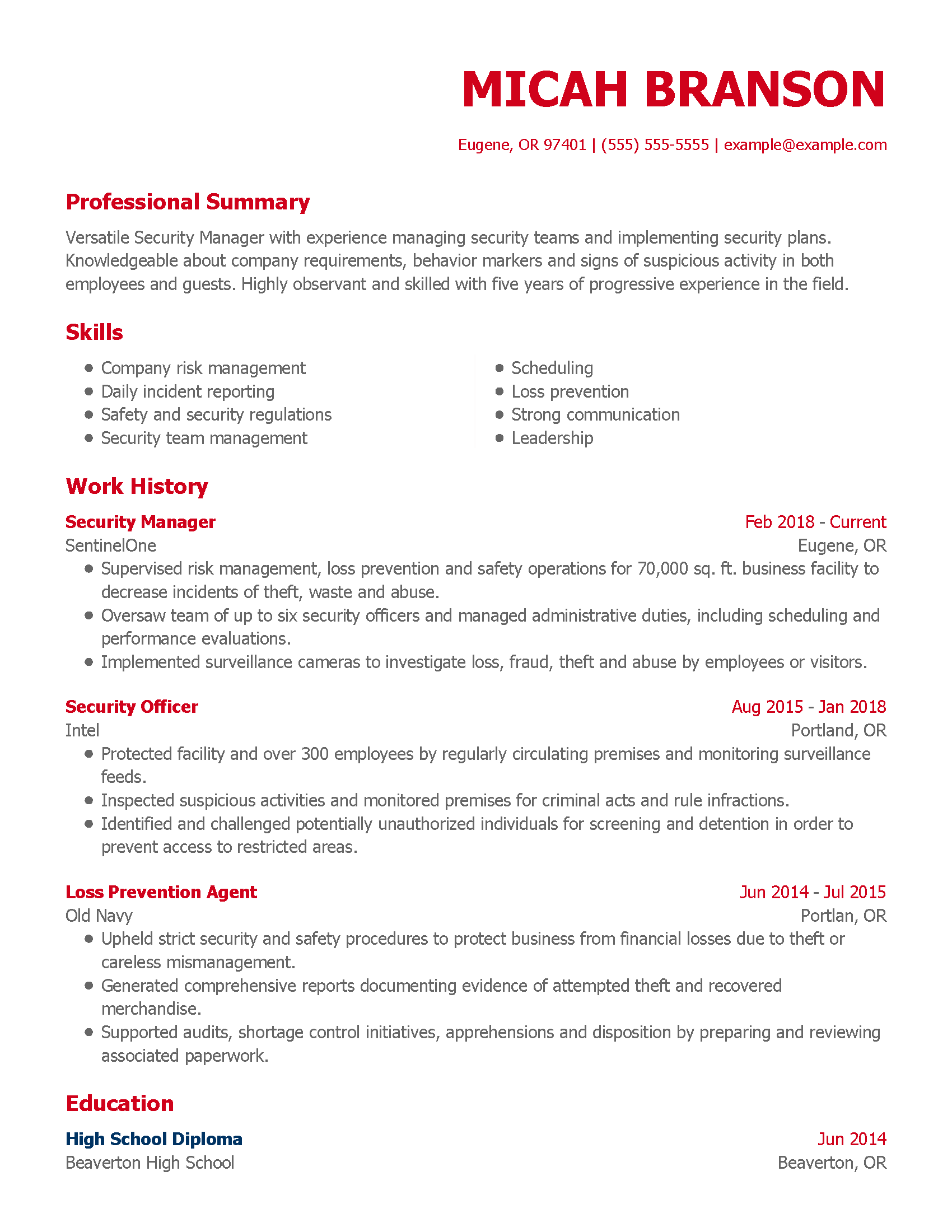
Security Manager Resume Examples & Templates for 2025
Explore security manager resume examples that showcase leadership, emergency response, and risk management. Get tips to highlight your skills and experience in keeping people and property safe.Build my resumeImport existing
